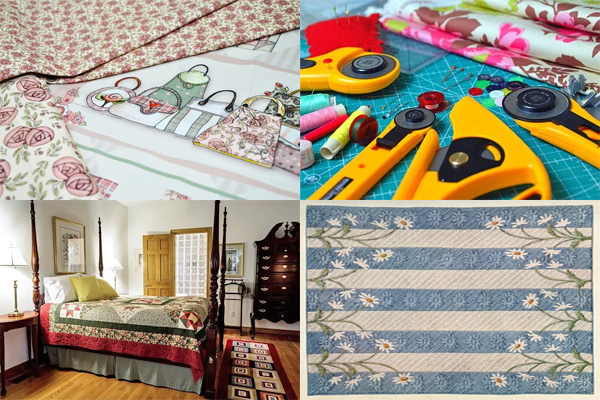Quilting
Traditional Quilting & Beyond
Today, with so many serviceable substitutes, it is not really necessary for women to make quilts, but the strange fascination about the work holds their interest. Quilt making has developed and progressed during the very period when textile arts in the home have declined under the influence of the factory. More quilts are being made at the present time and over a wider area than ever before.
Quilts, as known and used to-day, may be divided into two general classes, washable and non-washable, depending upon the materials of which they are made. The methods for constructing each class are the same, and are so very simple that it seems hardly necessary to explain them.
The name quilt implies two or more fabrics held together with many stitches. Webster defines a quilt as "Anything that is quilted, especially as a quilted bedcover or a skirt worn by women; any cover or garment made by putting wool, cotton, etc., between two cloths and stitching them together."
The verb, to quilt, is defined as "To stitch or to sew together at frequent intervals in order to confine in place the several layers of cloth and wadding of which a garment, comforter, etc., may be made. To stitch or sew in lines or patterns."
The "Encyclopedia Britannica" is a little more explicit and also gives the derivation of the name, quilt, as follows: "Quilting, sewing technique in which two layers of fabric, usually with an insulating interior layer, are sewn together with multiple rows of stitching. It has long been used for clothing in China, the Middle East, North Africa, and the colder areas of Europe but is now primarily associated with the construction of bedcovers and wall hangings."
The word quilt came into English from old French cuilte. This is derived from Latin culcitra, a stuffed mattress or cushion. From the form culcitra came old French cotra, or coutre whence coutre pointe; this was corrupted into counterpoint, which in turn was changed to counterpane. The word 'pane' is also from the Latin pannus, a piece of cloth. Thus 'counterpane,' a coverlet for a bed, and 'quilt' are by origin the same word."
Broadly speaking, from these definitions, any article made up with an interlining may be called a quilt. However, usage has restricted the meaning of the word until now it is applied to a single form of bed covering. In the United States and Canada the distinction has been carried even farther and a quilt is understood to be a light weight, closely stitched bedcover. When made thicker, and consequently warmer, it is called a "comforter."
Quilt Discovery Experience - Through the years, quilts have become documents of history. They are the products of their society, influenced by the culture, and the environment of the people who made them. The history of America can be seen in the history of quilts. Stitched into these quilts is the rich heritage of thrifty self-sufficient women who helped homestead the land, the history of families sewn into quilts one patch or one stitch at a time, and the legacy of the art of quilting, passed on from generation to generation.
Thousands of quilt blocks and patterns have been created and sewn through the decades. The quilt patterns or "blocks" that are displayed on the Quilt Trail were in the quilts used by pioneer women as they traveled West and homesteaded the prairie. They also depict other popular patterns used in 1862, when the Homestead Act was signed by President Lincoln, up until the Act was repealed in 1986.
Follow the trail to learn more about quilt making and the history of quilts and how they truly are documents of history... Find out more...
Related Links:
 Ancient Greek and Roman Needle Art
Ancient Greek and Roman Needle Art



